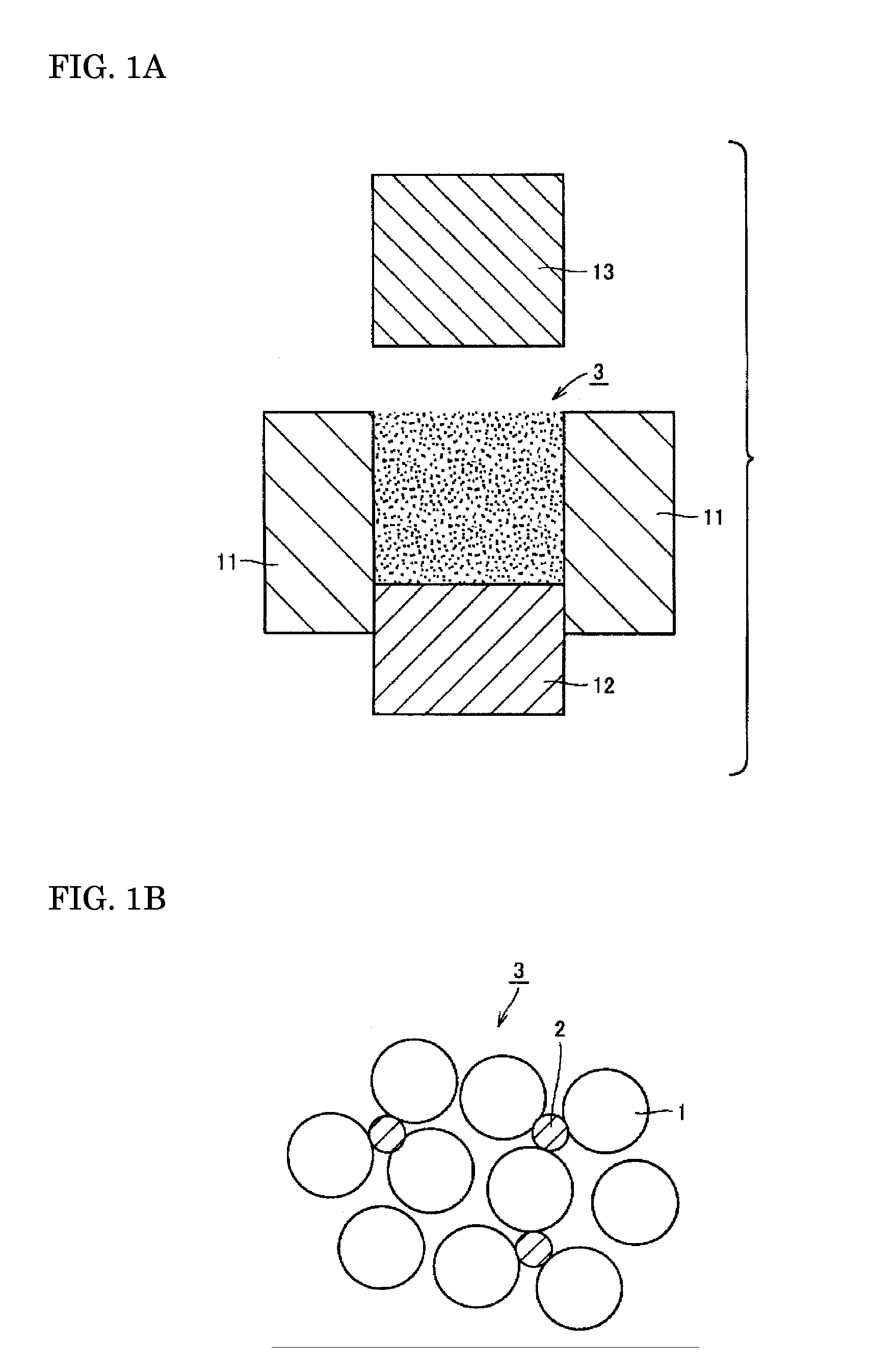Method for Molding Powder in Powder Metallurgy and Method for Producing Sintered Parts
- Summary
- Abstract
- Description
- Claims
- Application Information
AI Technical Summary
Benefits of technology
Problems solved by technology
Method used
Image
Examples
working example 1
[0062] The kinds of waxes shown in FIG. 1 were prepared and 0.2 wt % of each one was added to iron powder ASC100.29 (Höganäs Co.). Mixing was performed for 1 hour with a V-type mixer and the raw material (mixed powder) was prepared.
TABLE 1123456789KindEsterEsterEsterEsterEsterEsterAmidePar-Stear-affinicacidMelt-41506595110125786560ingpoint(° C.)
[0063] Using the prepared powder, press-molding was performed with a 30 mm diameter cylindrical mold. The mold temperature was 120° C. and the molding pressure was 800 MPa. The surface state of the molded article and the state of the bleeding of the wax were evaluated, and the results are shown in Table 2. In the tables of this Specification, extremely good results are shown by S, good results by Z, somewhat bad results by Y, and bad results by X.
TABLE 2Moldtemperature123456789RoomSurfaceSSSYXXYYXtemperaturestateBleedingSSZYXXXYYing 85° C.SurfaceSSSYXXYYXstateBleedingSSSYXXYYY110° C.SurfaceSSSSXXYZYstateBleedingSSSSXXYYY185° C.SurfaceSSSS...
working example 2
[0067] The types of waxes shown in Tables 4 and 5 were prepared and 0.2 wt % of each one was added to iron powder ASC100.29 (Höganäs Co.). Mixing was performed for 1 hour with a V-type mixer and the raw material (mixed powder) was prepared.
TABLE 4ABCDMelting point85858585Acid value (mg KOH / g)0.60.61.41.4Hydroxyl group value3.04.73.04.7(mg KOH / g)
[0068]
TABLE 5EFGHMelting point41414141Acid value (mg KOH / g)0.60.61.41.4Hydroxyl group value3.04.73.04.7(mg KOH / g)
[0069] Using the prepared powder, press-molding was performed with a 30 mm diameter cylindrical mold. When the raw materials with Samples A, B, C, and D added were used, the mold temperature was 120° C.; when the raw materials with Samples E, F, G, and H added were used, the mold temperature was set at room temperature. The press-molding was performed at a molding pressure of 800 MPa. The surface state of the molded article and the state of the bleeding of the wax were evaluated, and the results are shown in Table 6.
TABLE 6Mold...
working example 3
[0071] Ethylene bisstearic acid amide and zinc stearate were further added in the cases in which 0.2 wt % of the ester waxes of Samples 2 and 4 of Working Example 1 were added. The molding was evaluated under the same conditions as in Working Example 1 and the results are shown in Table 7.
TABLE 7MoldEthylene bisstearic acidtemperatureamideZinc stearateWax(° C.)0.030.20.350.50.030.20.350.52RoomSurfaceSSSSSSSStemperaturestateBleedingSSSSSSSSDensity7.507.467.427.327.527.487.447.35(g / cm3)4150SurfaceSSSSSSSSstateBleedingSSSSSSSSDensity7.537.487.447.367.567.507.467.40(g / cm3)
[0072] Compared with Working Example 1, the surface states were better, and further improvement in the surface state is expected if other non-melting waxes are added. This is thought to be because the static frictional force can be reduced by adding solid lubricants. Since the density is caused to be reduced by adding other waxes, the quantity added is determined by considering the balance between the lubricating pro...
PUM
| Property | Measurement | Unit |
|---|---|---|
| Temperature | aaaaa | aaaaa |
| Temperature | aaaaa | aaaaa |
| Temperature | aaaaa | aaaaa |
Abstract
Description
Claims
Application Information
 Login to View More
Login to View More - R&D
- Intellectual Property
- Life Sciences
- Materials
- Tech Scout
- Unparalleled Data Quality
- Higher Quality Content
- 60% Fewer Hallucinations
Browse by: Latest US Patents, China's latest patents, Technical Efficacy Thesaurus, Application Domain, Technology Topic, Popular Technical Reports.
© 2025 PatSnap. All rights reserved.Legal|Privacy policy|Modern Slavery Act Transparency Statement|Sitemap|About US| Contact US: help@patsnap.com



